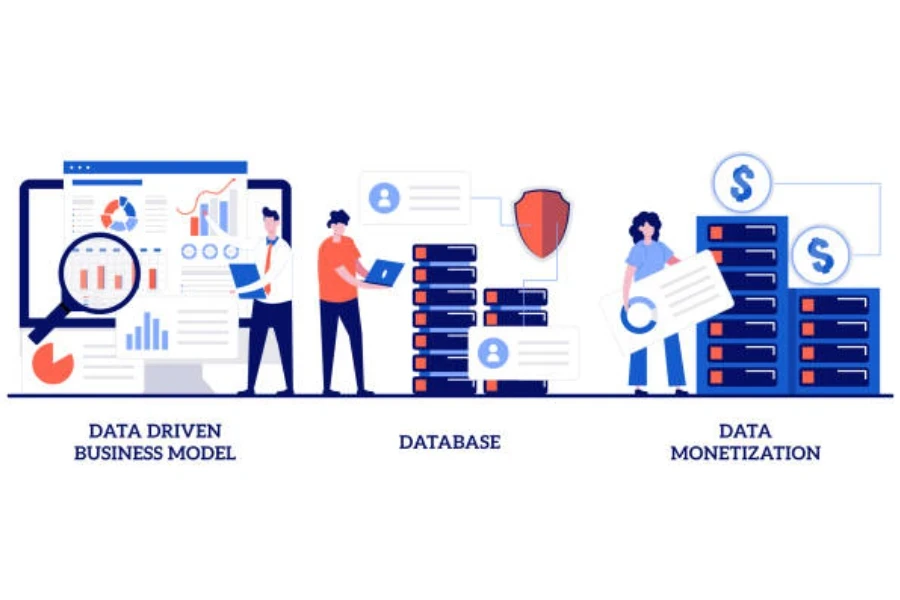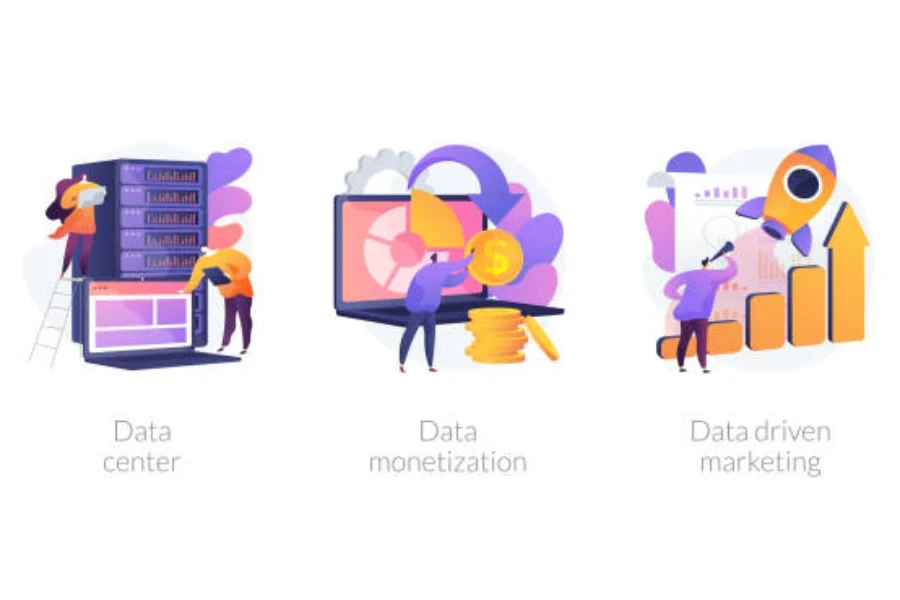In today’s business landscape, data has become an asset. To gain a competitive advantage and boost revenue, companies have discovered that having a clear data monetization strategy is key! That said, success with data monetization requires careful planning and implementation.
If you are optimizing business performance, an effective data monetization strategy should present the most straightforward path for extracting insights from big data. In this article, we will discuss what data monetization is, the benefits of data monetization, types of data monetization, and how to integrate data monetization to boost revenue.
Table of Contents
What is data monetization?
Benefits of innovative data monetization strategies
5 steps to integrating data monetization strategies to boost revenue
Conclusion
What is data monetization?

Data monetization is the process of quantifying company data and giving it monetary value. Incorporating data monetization strategies has become an essential strategy for businesses. By collecting and analyzing data effectively, companies can uncover insights and opportunities to turn data into new products and services that customers want. Data monetization strategies can help transform businesses’ data into valuable assets, thus generating income and driving growth.
Benefits of data monetization strategies

1. Creating new revenue streams
By classifying customer information based on gender, demographics, prospects, industry, and so on into target groups, the data owners can make the most out of the data. The company can make data-driven decisions that directly contribute to financial gains.
This data segmentation allows the business to personalize marketing campaigns and deliver highly targeted customer experiences and outstanding revenue.
2. Enhanced partnerships and collaborations
Through internal collaboration, many teams and departments can exchange data assets and insights. Organizations can combine data from diverse sources, enhancing the overall quality and depth of their data, by dismantling data silos and encouraging collaboration. For better decision-making and more focused monetization tactics, this integrated data can be used to provide a more thorough perspective of clients, operations, or market trends.
3. Competitive advantage by identifying opportunities
Most companies use data monetization to gain an intimate understanding of their customers, and in turn, they offer highly relevant products and services. This kind of strategy can give businesses a competitive advantage by providing insights and analytics that can be used to improve products and services, optimize operations, and make better strategic decisions.
4. Cost optimization
Data is valuable, but what is derived from data enriches that value. These insights can help to further segment customers, predict demand, optimize prices, and manage costs.
5 steps to integrate data monetization strategies to boost revenue
Step 1: Identify and understand data assets
The first step in integrating data monetization in a business is identifying and understanding the data value. You cannot monetize data that does not exist. There is a need to check whether any potential information is untapped and worth exploring. This involves conducting an audit to collect information about the organization and determining the potential value of the data. The business may need expertise in data to ensure the smooth operation of this process.
For example, let’s use ‘LaBelle Fashions’ for demonstration—a business that specializes in clothing, apparel, and accessories. This business can collect customer data through various channels, including online purchases, loyalty programs, and in-store interactions. By analyzing this data and understanding the assets they hold, LaBelle Fashions can aim to identify distinct customer segments and create personalized marketing campaigns.
Step 2: Define data monetization goals and objectives
The second crucial step is defining the goals and objectives of data monetization. Before embarking on the data monetization process, lay down the purposes of the process. You may have to conduct your in-house analysis to make the data economically beneficial.
You’ll also need to establish clear goals and objectives for the company. This will help ensure that data is collected and used to allow the business to reach its goals. There is a need to make distinctions before the process starts. After investing in the process, pivoting the overall data objectives takes a lot of work.
Let’s go back to our example of LaBelle Fashions. They could thoroughly analyze their customer data and identify three primary customer segments:
a) Young Fashionistas: This segment comprises fashion-forward individuals aged 18-25 who frequently purchase trendy and unique clothing items.
b) Busy Professionals: This segment consists of working professionals aged 25-40 who prioritize convenience and prefer high-quality, versatile clothing options.
c) Classic Style Seekers: This segment includes individuals aged 40 and above who value timeless fashion pieces and prefer elegant, sophisticated clothing.
This data can be used in-house. Once LaBelle Fashion has identified these segments, they can tailor-make campaigns to engage each group effectively. In the instance of the Young Fashionistas, they can leverage social media platforms like TikTok and Instagram using influencer collaborations. For the Busy Professionals, on the other hand, this kind of strategy may be less effective. In this case, they could use email or Twitter campaigns.
Step 3: Determine the appropriate strategy
Earlier, we discussed several ways of data monetization to develop a data platform that suits your company’s needs. To add to this, one should develop an appropriate strategy based on your objectives. These strategies can either be direct or indirect.
For example, for a clothing company like LaBelle Fashions, various strategies can be used. In such a case, LaBelle Fashions has to determine which strategy would suit them best. They can either use the data inhouse or they can also partner with other fashion houses and showcase their products to LaBelle’s customer base, earning revenue through advertising fees or commissions on resulting sales.
Determining the best strategy based on their objectives would help LaBelle Fashions to monetize their data easily.
Step 4: Invest in necessary technologies
They are several technologies businesses can invest in during data monetization integration to boost revenue. Below are few technologies that can be used:
Artificial intelligence (AI) and machine learning (ML)
AI and machine learning (ML) technology can analyze data trends, forecast customer behavior, and automate decision-making processes. Using AI/ML can result in focused marketing, tailored recommendations, and increased customer satisfaction, all of which contribute to data monetization.
Customer relationship management (CRM) systems
CRM solutions assist businesses in managing client data and interactions. Businesses can offer customized products and services by researching consumer behavior and preferences, improving their customer experience and expanding monetization potential.
Internet of Things (IoT) devices
IoT devices create enormous amounts of data from a variety of sources. Companies can optimize their products, improve customer experiences, and generate new revenue streams by collecting and analyzing data from connected devices.
Businesses should therefore invest in the necessary technologies based on their chosen strategy, the type of data they want to harness, and their intended usage of the data. On the other hand, they can also leverage data with existing software, tools, and technology. In the case of direct data monetization, LaBelle Fashions could use a CRM system to track down customer needs, styles, tastes, and preferences.
Step 5: Monitor and optimize the performance of the strategies
The last step that a company should adopt is monitoring and optimizing the performance of the data monetization strategies. Analyzing the data and monitoring the monetization process regularly ensures it is running smoothly and meeting the company’s goals.
On top of this, the easiest way to identify any issues or opportunities for improvement is through consistent review of the process, and measuring the success that the company has accomplished since the start of data monetization.
For example, in LaBelle Fashions, they can track their total sales revenue generated from clothing sales over a specific period of time ensuring they keep making profits. And in case there is a loss, they can change the data monetization strategy.
Conclusion
Integrating effective data monetization strategies is a key method for generating and increasing revenue. Businesses can therefore improve their profit model by understanding how to integrate data monetization strategies into their operations smoothly.
So if you’re keen to generate more income, then the integration of data monetization strategies could be the way forward for you!




